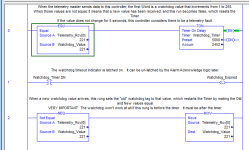defcon.klaxon
Lifetime Supporting Member
I am wondering what, if anything, can be observed in a slave PLC when sending/receiving data with MSG instructions. On the master side, you have the Enable, Done, and Error bits but because the slave just sits and waits for data to show up or be requested, there's no MSG logic on the slave side. Is there any way to know on the slave side when the MSG data shows up or is requested?



